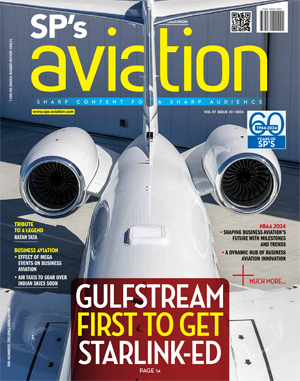INDIAN ARMED FORCES CHIEFS ON OUR RELENTLESS AND FOCUSED PUBLISHING EFFORTS

SP Guide Publications puts forth a well compiled articulation of issues, pursuits and accomplishments of the Indian Army, over the years

"Over the past 60 years, the growth of SP Guide Publications has mirrored the rising stature of Indian Navy. Its well-researched and informative magazines on Defence and Aerospace sector have served to shape an educated opinion of our military personnel, policy makers and the public alike. I wish SP's Publication team continued success, fair winds and following seas in all future endeavour!"

Since, its inception in 1964, SP Guide Publications has consistently demonstrated commitment to high-quality journalism in the aerospace and defence sectors, earning a well-deserved reputation as Asia's largest media house in this domain. I wish SP Guide Publications continued success in its pursuit of excellence.
Anthony LeVier (1913 - 1998)

He had a passion for invention, designing devices like the master caution warning light system, the automatic wing stores release, the first practical afterburner ignition system, the “hot microphone” intercom system and the placement of the trim switch on top of the control stick. Many of these features later became indispensable fits on combat aircraft.
Test flying has always been a rather risky and exciting profession. To take up an aircraft no one has ever flown before, put it through its paces and bring it safely back, is not a job even brave aviators might lightly volunteer to do. In the 1950s, for instance, test pilots were perishing at the rate of one a week. That is when Anthony LeVier, one of the greatest test pilots ever, was in his heyday. He joined the Lockheed Corporation in 1942 and continued as a test pilot for 32 years, evaluating some of Lockheed’s most famous aircraft.
Anthony “Tony” LeVier was born in Duluth, Minnesota, USA, on February 14, 1913. In his youth, he was more interested in learning about flying than in studies. He was one among a whole generation inspired by Charles Lindbergh’s epic solo flight across the Atlantic Ocean in 1927. Just 14 at the time, Tony LeVier in great excitement announced to his family, “I’m going to become an airplane pilot!” His mother took the declaration calmly, saying, “That’s wonderful, Tony; just remember to be a good one.” He signed up for aviation lessons when he was 15 and soon dropped out of high school to pursue flying full time. At 19, he obtained his commercial flying licence. Immediately, he plunged into a life of adventure, barnstorming, instructing and flying whenever he could. In 1936, he forayed into air racing, starting with the US national air races in Los Angeles. He became famous winning the 1938 Greve Trophy Race at Cleveland and the 1938 Pacific International Air Race at Oakland. However, the outbreak of World War II meant that most nonmilitary flying reduced. Although the US stayed out of the war, at least to begin with, everyone knew it would inevitably be sucked into the conflict. And, in anticipation, the US military aviation industry began feverish preparations.
When LeVier joined Lockheed he started by ferrying Hudson bombers built for the Royal Air Force, from the US to Canada. Next, he trained and checked out pilots on the Hudson and its transport variant, the Lodestar. But flight testing military aircraft considered to be the most challenging and risky form of peacetime flying, is what he yearned for. Eventually, he was accepted into Lockheed’s Engineering Flight Test Department to fly the PV-1 Ventura bomber and patrol aircraft, successor of the Hudson and forerunner of the famous B-37. Then he began intensive testing of the radical new Lockheed P-38 Lightning. This was a fighter aircraft with twin booms and a single central nacelle containing the cockpit and armament. It was named “fork-tailed devil” by the German Luftwaffe. LeVier investigated its control problems in dives at near-sonic speeds in order to reduce needless combat losses. This turned out to be the most extensive compressibility dive programme that had been conducted till then and not only improved the P-38’s performance, but also helped to pave the way for future high speed and supersonic flight.
Next it was the turn of the P-80 Shooting Star, the first jet fighter used operationally by the US. Designed and built by Lockheed in 1943, the aircraft was delivered in just 143 days after the start of the design process and quickly helped the US establish supremacy in aviation technology. It saw extensive combat in Korea as the F-80. On March 20, 1945, while LeVier was testing a P-80, the turbine disintegrated and severed the tail. He bailed out successfully, but severely injured his back in the process. Just six months later, he was back in the cockpit. In 1948, he took America’s first jet trainer aircraft, the T-33 T-Bird, up for its maiden flight. In 1954, it was the turn of the XF-104 Starfighter, dubbed “The Missile with a Man in It”. LeVier became the first person to cross a speed of 1,600 kmph while flying the F-104. Fifteen countries adopted it as their air superiority fighter and for the next 10 years, LeVier managed Lockheed’s Starfighter Utilisation Reliability Effort with North Atlantic Treaty Organisation (NATO) countries, contributing to greatly increasing operational safety. He also flight-tested Lockheed’s top secret U-2 high-altitude reconnaissance aircraft in 1955.





